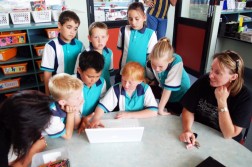The latest GDP figures released this week show that Australia has dodged a recession. Due in large part to the Rudd Government’s fiscal stimulus package, as well as interest rates so low that Reserve Bank governor Glenn Stevens is calling them "emergency" rates, Australia mostly avoided the deflationary spiral and crippling job losses faced by the US, UK and Spain.
For those of us accustomed to believing governments create more problems than they solve, it should be an enlightening moment. In a time of crisis, key policy makers such as Stevens, Treasury Secretary Ken Henry and Treasurer Wayne Swan had the courage to act quickly and boldly. It is now apparent to all but the Opposition and the editorial staff of The Australian that they made the right call.
But that doesn’t mean the stimulus has been universally well delivered by the Rudd Government. In fact, disturbing details of waste and mismanagement are beginning to emerge.
Last week, for example, Infrastructure Coordinator General, Mike Mrdak, released a report card on the stimulus spending. Buried on page 53 of the progress report was a brief paragraph explaining that the Government had decided to slash $750 million from its planned investment in social housing and more than $600 million from its program to encourage better home insulation.
Why? Well, it has emerged that another part of the stimulus — for Julia Gillard’s school halls and "multi-function centres" — has blown out by $1.5 billion. Apparently the original costings were based on an expected take-up of 90 per cent. In other words: 10 per cent of schools were expected to knock back a free building from the Government. In fact, only 78 of more than 8000 schools that were offered the buildings said no, leading to much higher costs than anticipated.
In contrast, if we are to believe the report, the cost of building new social housing was lower than expected, allowing the Government to slash 800 homes from its target of 20,000, and in the process save $750 million.
Welfare groups were understandably dismayed. The chief executive of Hanover Welfare Services, Tony Keenan, told The Age that "you would have to think that providing housing for homeless families would be a higher priority than providing a new school hall or science lab for a school that already has one".
It’s a fair point. The social housing provisions of the stimulus package were always one of the strongest aspects of the policy — as I wrote at the time it was announced. Australian federal governments have historically been reluctant to invest in public and social housing while giving huge tax breaks to home-owners and investors in areas like capital gains tax and negative gearing. The stimulus package offered an opportunity to redress that.
And the need is great. The bureau of statistics estimates that there are around 100,000 homeless Australians. Some of them are couch-surfing or staying in fundamentally inadequate shelters, boarding rooms and other short-term or emergency accommodation. Some are on the street. And if the costs of the program were indeed lower than originally forecast, here was an opportunity to build more social housing than originally planned. Instead, the nation’s poorest will get fewer houses.
There are also sound economic reasons to build more houses with public money. It was only a month ago that Glenn Stevens himself was lamenting the high cost of Australian housing in a speech at a Sydney business lunch.
"This ought to be the time when we can add to the dwelling stock without a major run-up in prices," Stevens said. "If we fail to do that — if all we end up with is higher prices and not many more dwellings — then it will be very disappointing, indeed quite disturbing."
Of course, Labor does deserve credit for addressing the issue of social housing at all. Content to watch property prices climb steadily past six, seven and eight times the median income, John Howard’s government did almost nothing about the issue for 11 long years.
And instead of criticising Labor’s cost-cutting, the Coalition is banging on about trivial things such as the Rudd Government’s promotional signs in state schools which extol the virtues of the stimulus package. As a result, the Australian Electoral Commission has had to make a ruling that the signs carry disclaimers so as not to influence voters on election day. It’s hard to think of a less important issue.
Meanwhile, the Government is predictably sticking to its talking points. Julia Gillard, who is both the Minister for Education and the Minister for Social Inclusion has argued that the cut to the housing budget "is not about cost blowouts". It’s hard to believe her, and even if we did, what does that say about Labor’s commitment to addressing the issue of homelessness — which, you might recall, was an election promise? It looks like the Government has made its decision based on what would cause it the least damage at the polls.
And voting’s not compulsory if you have no fixed address.
Donate To New Matilda
New Matilda is a small, independent media outlet. We survive through reader contributions, and never losing a lawsuit. If you got something from this article, giving something back helps us to continue speaking truth to power. Every little bit counts.



